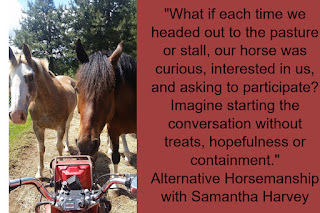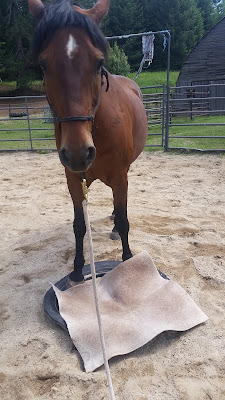How do you know when a green horse is ready to ride out on the trail with a timid rider?
This is a common questions for a lot of folks, feeling a bit of "Are we ready yet?" moments. So I'm going to break down riding out like a baking recipe.
First, do you you have all the necessary ingredients?
This means do you have effective "tools" in your communication? Can you influence your horse's thought before his movement? Can you interrupt him fixating on something when he is distracted or unsure? Can you regulate varying degrees of energy within each gait? Does your horse feel quiet at the halt, or does he feel like the halt is containment and as you let him walk out from it, does he rush off? How specific can you be/have you offered in your direction of the path he will move on? Can you offer him to do something other than "move out straight," (circles, turns around the tree, rock, etc. that are thoughtful and soft vs obedient,)? Can you work around different places at your barn/pasture/home facility and have him interested, or do you notice you feel his heart rate increase under the saddle and his breathing become short and raspy or dragon like, and he starts looking for the other horses?
Next, we have to "mix" the ingredients.
At all properties there is usually a safer zone and an imaginary boundary where the horse becomes a bit unsure. Use this opportunity not to "make" the horse tolerate the uncomfortable place, but rather help him think through it. This means giving short, specific, direct communication and breaking down the big "let's ride through this spot tolerating it and feeling uncomfortable," to instead, small, intentional, soft pieces where he learns to think through his worry, rather than flee from it. Eventually you'll be able to link the pieces together and ride "through" with it concerning your horse.
This is NOT repetitiously practicing riding back and forth, back and forth, in a scary area to get your horse "used to" a specific location. That approach does not offer confidence for the unexpected moments and things that can arise on the trail that you may not get to "practice," such as when the moose jumps out.
The horse should become more relaxed for your efforts in helping him through an area that bothers him. If he isn't letting down the tension in his body, concern in his brain, softness in his response to you, then something has been missed and you'll have to go back and revisit the quality of your ingredients.
What about the rider's confidence?
Learn how to take the pressure off of yourself. The timid/unsure rider comes from a place of feeling "surprised" by what the horse does, or feeling ineffective towards their horse.
So, I want you to learn how to practice assessing and having mental conversations (without your horse in hand,) allowing you the time to think through various scenarios. I want you start to think back and learn from the past, to moments when you started to see behaviors in your horse that were concerning. Then think through, how your horse "handled it" and what you your communication was towards your horse. Then assess how early did you recognize those behaviors (which are a reflection of the horse's brain and emotions) and if you were "hopeful" that your horse would just let it go on his own, or the passive rider trait. This is a vicious cycle that occurs with timid/fearful riders. And no, horse's cannot rationalize if the way they are choosing to do something isn't safe, therefor the human needs to interject.
But this is where fear in the rider comes in. If you don't have quality ingredients, such as being able to ask your horse's brain and body to pause, or stop, and check in with you, then you will typically not offer a "boundary" for fear of an over reaction from your horse. And of course not wanting to have a "blow up" during the moment of peak stress. That is why it is so crucial to have a mental availability, or willingness, for your horse to hear you, and offer a "try" in whatever you've asked of him, BEFORE you present a location that could potential cause him to be unsure. The time to "fix" your tools is not at the time of peak stress.
So, since hind sight is 20/20, I want you to think about times your horse was starting to show concern, such as when you START to feel him getting looky, walking a bit faster, not quite as responsive to an aid, and I want you to talk yourself through your options of how you could communicate with him in order to influence a change in his BRAIN first, that will result in a different behavior from him. The earlier you influence a change in thought, the faster he will diffuse his worry or concern, therefor you've "drained" his cup from overfilling.
This conversation is not about critiquing the horse for what he is doing, he is honestly telling your his concern, so if all you do is tell him "no" it does not help him. But if you offer a "not that, but how about this?," re-directing his thought and focus, it is offering a positive alternative, or a "way out" from his mental discomfort.
The other huge factor is most folks shut down, or quit communicating, at the time the horse needs them the most. Learn what your own triggers are when you go passive in the saddle, and come up with ideas for yourself to "try out" that can keep you mentally present and offering conversation with your horse. The more you learn to stay present in the moment with your horse, the more supported he will feel, and he will gain confidence, offering softer and more willing responses, which in turn builds your own confidence.
How does this all tie together for riding out?
Once you have the ingredients, have done your own mental preparations, practiced using quality communication to work through your horse's bother, or you've now mixed the ingredients, you are ready to "bake."
Just as with cooking, even if you have the correct amount of everything mixed together, if you leave the batter in the oven too long, it gets burnt or overdone.
For green horses and insecure riders, this is such a frequent occurrence. They have this idea that "trail riding" needs to be a certain distance, or amount of time, and they tend to "over do" or burn out mentally, because it was initially too long mentally for the horse and rider.
So the initial trail ride(s), might be to the mailbox at the end of the driveway and back. Or a hack around half the property. The horse does not have the ability to decipher between what is a "real" trail ride and that which is not. That comes from human's judgement and the horse world's standard. But who cares about all that? Because really what is the goal? To expand you and your horse's confidence and ability to ride out into the real world, and be better mentally and emotionally for the experience.
So think of it like the competition arena. You don't show up to the show without practicing, right? So don't head out on the three hour ride without practicing in incremental, quality shorter rides.
So how do you know when you've baked your ingredients and you get the desired end result? Your horse will tell you. When whatever conversation you present feels soft and willing, when he gets distracted but can let it go when you ask him to re-focus without him getting defensive, when you can communicate without feeling mentally and physically exhausted after 15 minutes (part of which comes from folks not remembering to breath as they are attempting to help their horse.) And really, you'll feel the fear or unsureness in the horse diminish and his curiosity (different from fixation) perk up. He's telling you, with your support, he's ready to take on the world and ride out.
Would you like the opportunity to work with Sam? Find out about Full
Immersion Clinics,
Private Clinics,
Remote Coaching, and more!
















